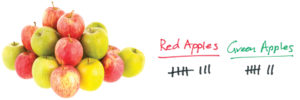
What Is Data?
Data is information that we collect to answer questions or solve problems. It can often be helpful to organize data into a list, table, or graph to help us interpret it, recognize patterns, and draw conclusions.
Why Is Learning About Data Important?
Data helps people understand the world around them and make decisions. We gather information to answer questions such as:
- “Are there enough cookies for everyone or do I need to put more out?” Count how many people and cookies there are.
- “Should I wear my tall snow boots tomorrow?” Check the weather forecast to find out how many inches it is going to snow.
- “What type of ice cream should we get for a party?” Survey people’s favorite flavors to find out.
What Do Children Need to Know About Data?
Children can learn how to:
- Collect data: Count how many people are in line to use the slide and the swings to see which one has a shorter wait.
- Sort or organize objects by different features: Arrange classroom books by the first letter in the title so that favorite books are easier to find.
- Ask questions that can be answered by collecting information: For example, “Do we have enough forks and spoons for everyone eating lunch at this table?”
- Organize and represent information: Use tally marks or simple bar graphs to show what colors of cars children see.